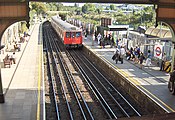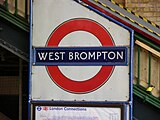West Brompton station
 From Wikipedia - Reading time: 13 min
From Wikipedia - Reading time: 13 min
| West Brompton | |
|---|---|
 Station entrance | |
| Location | West Brompton |
| Local authority | Royal Borough of Kensington and Chelsea |
| Managed by | London Underground[1] London Overground (western platforms only)[2] |
| Station code(s) | WBP |
| DfT category | E |
| Number of platforms | 4 |
| Accessible | Yes (except District line westbound platform)[3] |
| Fare zone | 2 |
| London Underground annual entry and exit | |
| 2019 | |
| 2020 | |
| 2021 | |
| 2022 | |
| 2023 | |
| National Rail annual entry and exit | |
| 2018–19 | |
| 2019–20 | |
| 2020–21 | |
| 2021–22 | |
| 2022–23 | |
| Key dates | |
| 1 September 1866 | Opened (WLEJR) |
| 12 April 1869 | Started (Terminus) (DR) |
| 1 March 1880 | Started (Through Service) (DR) |
| 21 October 1940 | Ended (WLL) |
| 1 June 1999 | Restarted (WLL) |
| Other information | |
| External links | |
| Coordinates | 51°29′12″N 0°11′45″W / 51.4866°N 0.1957°W |
West Brompton is a station located on Old Brompton Road (A3218) in West Brompton, West London for London Underground, London Overground and National Rail services. It is immediately south of the demolished Earls Court Exhibition Centre and west of Brompton Cemetery in the Royal Borough of Kensington and Chelsea.
The station is on the Wimbledon branch of the Underground's District line between Earl's Court and Fulham Broadway stations, the Overground's West London line between Kensington (Olympia) and Imperial Wharf stations, and National Rail services are provided by Southern
The station's location on the West London line forms a borough boundary and its tracks are shared between Kensington & Chelsea and the London Borough of Hammersmith and Fulham. Since 2000 it has been a Grade II (starting category) Listed Building.[10]
History
[edit]The West London Extension Joint Railway (WLEJR) was opened in the early 1860s. It joined the southern end of the West London Joint Railway at Kensington (Olympia) station with Clapham Junction station and ran through West Brompton although a station was not opened until 1866.[11] The original station was designed by the chief engineer of the Metropolitan and District Railway, Sir John Fowler[12] and thus has local railway associations that go back to 1838.[13] The current Lillie (road) bridge dates from 1860 and is the work of Fowler.[13] The soon to disappear Lillie Bridge Railway and Engineering Depot, opened in 1872, is close by. Other historic associations are with the Lillie Bridge Grounds, a noted 19th c. athletics, cricket, ballooning and cycling venue adjacent to the West of the station and Brompton Cemetery adjacent to the East. From 1887, the station gave access to John Robinson Whitley's Earl's Court exhibition grounds and from 1937 to 2014 it was the alternative access to Earls Court Exhibition Centre, now demolished.
On 12 April 1869, the District Railway (DR, now the District line) opened its own station adjacent to the WLEJR station as the terminus and only station on its extension from Gloucester Road station (Earl's Court station did not open until 1871). The original plan was to connect the DR to the WLEJR but this did not take place.
On 1 March 1880, the DR opened an extension south from West Brompton to Putney Bridge.[14] In 1906 a heat wave affected the railway such that one of the Underground's electric rails was warped at the station; trains coasted over the affected track until it was repaired.[15]
In 1940, during World War II, several WLL stations sustained bomb damage. Passenger services on the WLL between Willesden Junction and Clapham Junction were withdrawn on 21 October 1940. The Underground station remained in use and the WLL continued in use for freight traffic. The WLL station buildings and platforms were subsequently demolished.
Full passenger services resumed on the WLL in 1994, but it was not until 1 June 1999 that new Network Rail platforms were opened at West Brompton by the then Minister of Transport, Glenda Jackson. There is a commemorative plaque to this effect on the Western lift tower. The station design was by Robinson Kenning and Gallagher of Croydon.[16][17] The lift tower design is an echo of the decorative brickwork by the 19th c. City of London architect and surveyor, John Young designer of the nearby Empress Place and Lillie Road terrace in Fulham.[18] The works were funded by the Royal Borough of Kensington and Chelsea and the London Borough of Hammersmith and Fulham on whose border the station lies.
The WLL platforms do not have a separate entrance and access is from the Underground station. The District line serves platforms 1 and 2 and the WLL serves platforms 3 and 4. There is a fence between platforms 2 and 3, but they are on the same level and it is possible to pass directly between them.
There are lifts to both overground platforms for wheelchair access, and this means there is also step-free access to the eastbound District line platform, but not the westbound one. The station is in a cutting that is covered at one end.
Services
[edit]National Rail
[edit]National Rail services at West Brompton are operated by Southern and London Overground using Class 377 and 378 EMUs.
The typical off-peak service in trains per hour is:[19][20]
- 4 tph to Stratford via Willesden Junction
- 1 tph to Watford Junction
- 4 tph to Clapham Junction
- 1 tph to East Croydon
Additional services call at the station during the peak hours.
During the late evenings, London Overground services at the station run between Clapham Junction and Willesden Junction only.
London Underground
[edit]The typical off-peak London Underground service on the District Line in trains per hour is:[21]
- 6 tph to Tower Hill of which 3 continue to Barking
- 6 tph to Edgware Road
- 12 tph to Wimbledon
Additional services, including trains to and from Dagenham East and Upminster call at the station during the peak hours.
| Preceding station | Following station | |||
|---|---|---|---|---|
| Southern | ||||
| Preceding station | Following station | |||
| Kensington (Olympia) towards Stratford
|
West London Line | Imperial Wharf towards Clapham Junction
| ||
| Preceding station | Following station | |||
| Fulham Broadway towards Wimbledon
|
District line Wimbledon Branch
|
Earl's Court towards Upminster or Edgware Road
| ||
| Disused railways | ||||
| Chelsea & Fulham | West London Railway | Kensington (Olympia) | ||
Image gallery
[edit]-
Station, entrance on Old Brompton Road in 1963
-
West Brompton underground station platforms, with northbound train arriving (September 2006)
-
West Brompton underground station footbridges (September 2006)
-
West Brompton overground station – southbound Southern Class 377 Electrostar service at the platform (September 2006)
-
London Overground branded sign at West Brompton Station.
-
Vintage sign, from before the Johnston typeface was standardised
-
Green verges beside the track into West Brompton station, adjacent to Brompton Cemetery
References
[edit]- ^ "Safety boost as London Underground to take control of 11 Silverlink stations". Transport for London. 5 December 2006. Archived from the original on 13 December 2014. Retrieved 19 February 2015.
- ^ thetrainline
- ^ "Step free Tube Guide" (PDF). Transport for London. April 2021. Archived (PDF) from the original on 15 May 2021.
- ^ "Station Usage Data" (XLSX). Usage Statistics for London Stations, 2019. Transport for London. 23 September 2020. Archived from the original on 9 November 2020. Retrieved 9 November 2020.
- ^ "Station Usage Data" (XLSX). Usage Statistics for London Stations, 2020. Transport for London. 16 April 2021. Retrieved 1 January 2022.
- ^ "Station Usage Data" (XLSX). Usage Statistics for London Stations, 2021. Transport for London. 12 July 2022. Retrieved 7 September 2022.
- ^ "Station Usage Data" (XLSX). Usage Statistics for London Stations, 2022. Transport for London. 4 October 2023. Retrieved 10 October 2023.
- ^ "Station Usage Data" (XLSX). Usage Statistics for London Stations, 2023. Transport for London. 8 August 2024. Retrieved 16 September 2024.
- ^ a b c d e "Estimates of station usage". Rail statistics. Office of Rail Regulation. Please note: Some methodology may vary year on year.
- ^ Historic England. "Details from listed building database (1385365)". National Heritage List for England. Retrieved 9 October 2015.
- ^ Hobhouse (1986), footnote 55.
- ^ Walford, Edward (1878). Underground London: Its railways, subways and sewers. London: Cassell, Petter & Galpin. pp. 224–242 – via British History Online (transcription).
- ^ a b Hobhouse (1986).
- ^ "Extension of the District Line to Fulham". Daily News. London. 28 February 1880. p. 6 – via Newspapers.com.

- ^ "Effect of Heat on Rails – Mishap on the Metropolitan Line". The Guardian. 14 April 1906. p. 5 – via Newspapers.com.

- ^ "(unspecified)".[dead link]
- ^ "West Brompton Station". RKG. 2013. Archived from the original on 5 March 2016.
- ^ Blower's Architect's, Surveyor's, Engineer's and Builder's Directory. T. Blower. 1860 – via Archive.org.
- ^ Table 59, 66, 170, 176 National Rail timetable, June 2024
- ^ "London Overground Timetable: Stratford to Richmond and Clapham Junction" (PDF). Transport for London. Retrieved 13 December 2023.
- ^ "District Line Timetable". Transport for London. Retrieved 13 December 2023.
- Hobhouse, Hermione, ed. (1986). "The Kensington Canal, railways and related developments". Survey of London: Volume 42, Kensington Square To Earl's Court. London. pp. 322–338. Retrieved 15 October 2016 – via British History Online (transcription).
{{cite book}}: CS1 maint: location missing publisher (link)
External links
[edit]- Train times and station information for West Brompton station from National Rail
- London Transport Museum Photographic Archive Archived 4 March 2016 at the Wayback Machine
- London's Abandoned Tube stations – West London Line
- West Brompton, SubBrit disused stations project
- www.Old-maps.co.uk – West Brompton station, 1874
 KSF
KSF






